How to grow chilli
How to grow chilli is important if you are arthritic. Red-hot is the word.
Or do you spell it chili? They are just as hot.
So you like the flavour, and perhaps even the burn of chillis. You are not alone, half the world loves them; they are nutritious, full of vitamins C and B; and many minerals. However they are obviously eaten in small-quantities, so I cannot say you will get a significant amount of these nutrients from your jalapenos and peppadews.
We eat them because they taste good and will make otherwise boring foods more interesting; and as far as I know you can enjoy them without any detrimental effect unless you have an ulcer. They are also a strongly anti-inflammatory spice.
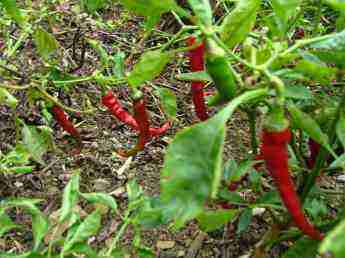
This page was last updated by Bernard Preston on 9th January, 2023.
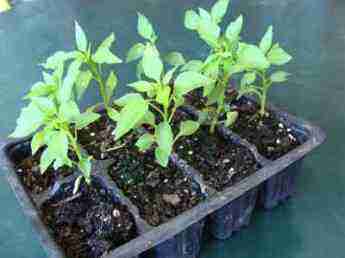
They are an important part of your armamentarium of coloured-foods that give us protection against tumours. The reds particularly have lycopenes that halve the rate of prostate cancer; enjoy your tomatoes and chillies. Actually guavas and watermelons are the richest sources.
How to grow chilli? It is not difficult, as we shall see.
This is a page in development as our plants grow. I'll just have
to curb my patience before making that homemade spicy sauce.
It was in development but is now complete; I have just updated it to add something on jalapenos and smoking chilies.
Fresh tomato recipes and chilli go marvelously together. Mostly we don't eat them for themselves but to enrich other dishes; like how to enjoy and cook eggplant.
This kale and spinach sauce would be very dull without chili; it's one of our favourite dishes to go with pasta and other starches.
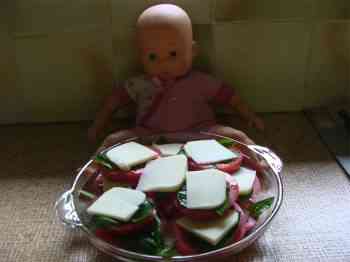
How to grow chilli
How to grow chilli as the pepper family is full of vitamin C and unexpectedly is one of the strongly anti-inflammatory foods.
Week 1 is the 2nd October in the Southern Hemisphere.
Actually that's a bit late. In the latter years, I have planted them in the spring once the danger of frost is over and they do even better; say April or May in the Northern Hemisphere.
Choose your site in full sun. You really only need one plant but eight came in a tray, so I have planted all of them. They are self-pollinating so, if you share a tray with seven friends you should all be happy.
Clear out the ground, removing all traces of the last crop and weeds. The piece I've chosen is about ten foot square or 3m2. We had limas in here last so it is good to follow a legume with a leafy crop; the beans have left a residue of nitrogen in the soil that is now available.
On the subject of organic gardening, one is very dependent on bacteria that form on the roots of legumes like beans and peas.
These little bugs trap nitrogen from the atmosphere which is vital for your organically grown vegetables if you are determined not to use chemical fertilizers for dark-green leaves.
In any case we should be eating plenty of legumes. Reducing your red meat, and replacing some of it with beans, peas and lentils will certainly improve your well-being.
We are not vegetarians but we do supplement our diet with plenty of legumes to keep our cholesterol down. In any case fresh peas and beans from the garden are delicious; and the nitrogen they leave in the soil is just what your chillies need.
A common Dutch saying compares retirement with sitting behind the geraniums that fringe many of the television rooms in Europe. It is synonomous with becoming a couch potato, and much was made by my Dutch patients of the fact that I was returning to Africa to sit behind the Cape violas; Kaapse viooltjes in Dutch.
I could not bring myself to hoe out these beauties; they are weeds really in the vegetable garden, but so beautiful at the moment, and a reminders of the many friends that I left behind in Europe. There common name is Heart's Ease; that describes our gardening perfectly.
Sitting behind the Cape violas
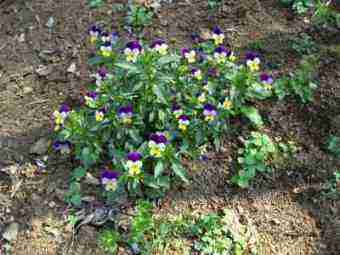
Cape Violas
There's nothing couch potatoish about gardening in Africa, however; it is hard work
making a compost pile without the help of a serf. But it definitely beats pounding the streets or going to the gym in my opinion.
Dig some small holes
I started digging some holes, about a spade square, and as deep. They do not need to be large unless you have very hard, unworked ground.
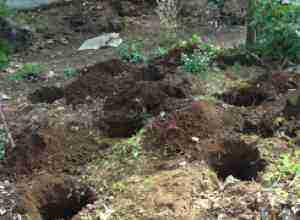
Starting a compost pile
Starting a compost pile is easy but maintaining it requires fairly rigorous hard work; do your lower back exercises. Although they are hardy plants, the nutrition will certainly be much improved in how to grow chilli if you use plenty of humus.
Your own organic compost is the perfect place for your chilli plants to spread their roots. I will not pretend that starting a compost pile is light work.
There is no place farther from sitting behind the geraniums
than building a compost heap. It is hard physical work, but very
rewarding. And oddly, I have a difficult back too at times but it has
been thriving on gardening. It is the chair that is the downfall of the
average lumbar spine, including mine. Two-thirds of the secret of preventing the reoccurrence of a nasty sciatica is to vacate the couch and start these core exercises.
It is astonishing how 5 foot of kitchen and garden waste decomposes down in three to
four months into two miserly feet of humus like this. Made late last
summer from all the cuttings and clippings of the garden the bacteria,
worms and a million creepy-crawlies have done a fine job of
concentrating the nutrients in all those leaves.
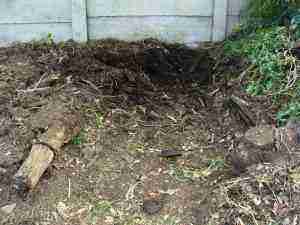
FILL THE HOLES WITH COMPOST
One wheelbarrow of homemade
compost is what these eight holes got. It filled the hole about half
way, and then of course you simply cover with the soil you have just dug
out, compacting lightly.
STAKES
Chilli plants are rather slender so I have taken the precaution of first placing a stake into each hole. Just in this instance, a thin bamboo cane that I have been chopping back.
These plants remain quite small, so it is easy to trample them. So I have placed a small stick on the other side of each seedling.
In actual fact, when heavy in fruit, their branches need to be supported with a forked stake; otherwise the first gust of wind and over they go. So I now put in a cane right away to save the schlep of doing it later and maybe disturbing the roots.
PLANT YOUR SEEDLINGS
Make a small hole and pop your seedling into the hole, making sure that it is at the same level as in the seedling tray. Firm the soil around your seedlings and water immediately to ensure the soil is in contact with the fine seedling roots.
Often I would put a little cap on the seedlings for a couple of days to protect them against the fierce African sun, but tomorrow is predicted to be cool and misty with a light drizzle, so it will not be necessary.
How to grow chillis is not difficult.
Chili plants
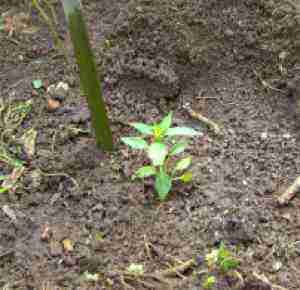
Week 5
Come back in a month's time, beginning of November to view our progress with growing chillis. Better still, get your own plants into the ground so you too can enjoy con-carne recipes.
They have not grown much but there are lots of tiny white flowers. The plants are looking very healthy.
Week 8
The plants are still quite small but already bearing fruit.
Week 13
Today I picked my first chilli. The thrill of how to grow these treasures comes with the first fruit. Mm, I wonder if the padre would enjoy a few? The first bush has four fruit, three still green; the other plants have put their energy into growing much taller and now have flowers.
Low carb chilli
Today I had my own chilli from the garden for our authentic hummus recipe; chickpeas are number two in the foods that lower cholesterol. Do you know what number one is?
Chillis also have proven cholesterol-lowering properties by the way; anything to get off those nasty statins.
A fermented peppadew sauce, known as Sriracha in Mexico is so easy to make; and will spice up any sandwich or hamburger. The simple processing takes just a few days and reduces the influence of so-called antinutrients and adds a quite different dimension to the flavour.
Some of the low carb foods like chickpeas, lentils and even a green salad can taste a little dull. There is nothing like adding spices to make them more interesting. Chilli, garlic and turmeric all go a long way to making these essential but perhaps rather tasteless dishes more palatable. Try using sweet-basil and your own favourite herbs too.
If you know about resistant starch, then even new potatoes with a slither of chilli can be enjoyed by those who are watching their weight; or are diabetic.
Vitamin C
After citrus, the pepper family is the second best source of vitamin C. How to grow chilli is not just for the fun of it, and the flavour it brings to your cooking; it's about better health too.
Whilst there are not many cases of scurvy around these days, there are certainly millions of people who are mildly deficient, and some seriously so.
Vitamin C is one of four nutrients that have been identified as being essential in the war against the rapidly escalating frailty syndrome; premature loss of get up and go, vitality and muscle strength.
In short, eating a healthy diet, rich in coloured foods and nutrients is not small beer; it makes the difference between a happy sitting under the trees one once planted, sipping tea, and even a sherry, watching the grandchildren growing up, and premature disability and an early demise.
One of the joys of the jalapenos is that with luck they will sprout again next spring; just cut them back in the autumn.
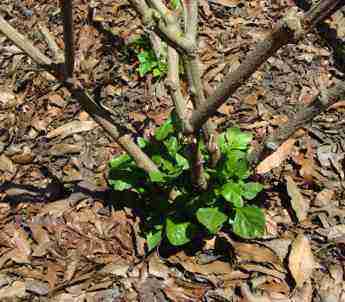
I love these babies as they make a green chili sauce recipe that's not too hot for my European tongue. Give them another week to mature and they will start to burn.
You will have a huge surplus; how to preserve jalapeno peppers and in fact all chillis is a breeze.
Keeping your own seeds is particularly successful with peppers; you really do not need to spend a fortune at the gardening shop.
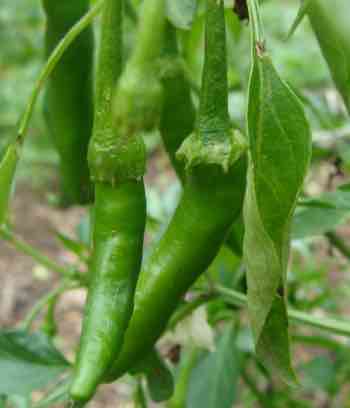
The year of the peppers
The pressure of treating patients has meant that I have not had the time to build pages on how to grow all the other peppers; they all belong in the extraordinarily diverse family of capsicums
Probably one of the most important vegetables in our garden, peppers are rich in capsaicin, essential phytonutrients and vitamin C especially.
Read more about the other capsaicin health benefits.
But they are all flourishing in our garden. Next summer perhaps I will have more time for writing about our backyard. You could of course start yourself growing them in your northern spring.
Interesting that capsaicin, the burning stuff, found mainly in the placenta that holds the seeds, is a very powerful anti-inflammatory agent. Chilis are one of the many foods that help prevent anger in joints, muscles and the lumens of our blood vessels; and even the lining of the gut.
Speaking of writing my fourth book is right off the press; and it is hot. It has nothing to do with how to grow chilli but it is certainly spicy. Look carefully at the cover.

Backcover Book I: The Bostonians.
A Family Affair is the heart-warming trilogy about family with a difference. It has two Moms, but no Dad.
Janet has a happy childhood; it is at her Diocesan School for Girls where she first tastes the forbidden fruit. But Santie’s mother dies and the child is sexually abused by her father. Whilst at the Police College a gate slams shut, wiping all memory of her abused childhood from her mind, but leaving her very conflicted.
After studying law, their friendship blossoms whilst doing their articles but Janet is raped by their boss at a beach party. Deciding to keep the child, Klein-Jan becomes the honey in the sandwich that sweetens and cements their relationship; until the toddler is kidnapped by his father.
Darkness ensues and Janet becomes very depressed. Eventually, in desperation their gynaecologist suggests that they have another child. But how do two women conceive a baby?
Book II: Peter’s Children
Enter Peter Thomas; is it possible for a man to be hoodwinked into siring four children and be none the wiser?
Book III: The Return
Concealed in Holland from Interpol by his father, Klein-Jan now aged twenty undertakes a journey to discover his roots.
Set in South Africa, A Family Affair is both a lighthearted and easy read, but also takes an inside look at serious issues; women in love, rape and abortion. AIDS and the profound love of a grandmother also come into the equation; it was from her home that KJ was kidnapped.
It is rather more than a Mills and Boon, I think you will find. Sample a few free chapters of Bernard Preston at the A Family Affair home page from the navigation bar above.
Unsure? Read a few sample chapters. Jan Jansen ...
Preserving the polyphenols
Preserving food obviously goes back millennia into the mists of time. One way is to ferment either the whole fruit or the juices; this cherry-guava honey mead is a great favourite.
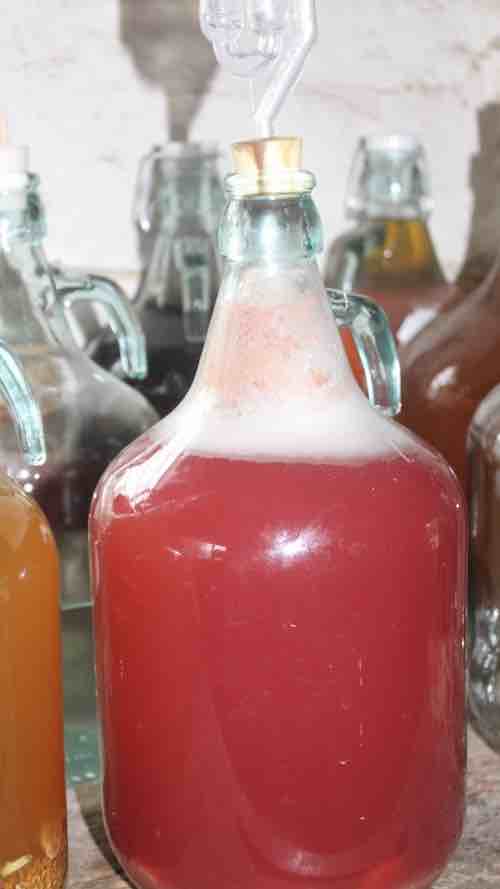
Coloured foods are rich in the polyphenols that scientists have found protect our bodies from so-called reactive oxygen species; they are the little devils that make a normal cell go haywire, grow proliferatively and turn into malignant tumours.
This spicy peppadew mead is another favourite.
Vitamin C
WebMD says:
Although citrus fruits are the best known source of vitamin C, many veggies and fruit also have abundant levels of C. Most adults need between 70 and 100 mg a day. Half a cup of sweet red pepper or a six ounce glass of orange juice provides that much and more.
Actually WebMD is not accurate here. 6 ounces of orange juice out of a carton does not contain even close to 75mg of vitamin C. They make no distinction between OJ that and freshly squeezed orange juice and there is a world of difference. Squeeze your own oranges if you want orange juice. It does not take long with the aid of an electric juicer but in fact I still use the hand juicer when wanting only one glass.
So, if you want to increase the vitamin C in your diet think of home squeezed orange juice and how to grow chilli and sweet peppers should be in the planning of this year's garden.
In choosing your minimum of five coloured-foods per day try to eat from a broad a spectrum of fruit and vegetables as possible. I aim for ten as that is where the antioxidants, the tumour preventers. It's amazing what you can grow in even a small garden if you're committed.
Are you still on a B and W diet? There's trouble coming; it is time to upgrade to colour.
The most important ingredient in chilis is in fact not the vitamin C but a substance called capsaicin than has proven painkilling, anti inflammatory and anti cancer properties. It's the burn in chillis; it's found in the pulp and especially the membranes that hold the seeds, but according to Wikipedia not much is found in the seeds.
Like all of the chilli family, pepperdews start out a lovely green colour; but then, given some hot African sun, they too become really hot. Eaten green in a salad they are fine, but once they turn red, we take out the chilli pips.
It is a moot point; should you remove the seeds and eat more of the flesh, or less, but seeds and all? However, if you want to enjoy the health properties of chili, you should at least eat the white membranes within the chili; there is where most of the capaicin is found apparently.
Dinkum, how to grow chilli is not difficult; they like a sunny spot in the garden, plenty of compost and frequent watering, just like any vegetables. You will have to support the branches otherwise they will break under the weight of the fruit. Actually that fruit growing in your flower beds adds so much colour; you will get comments from your friends, some ribald!
Newsletter
Our newsletter is entitled "create a cyan zone" at your home, preserving both yourself and Mother Earth for future generations; and the family too, of course. We promise not to spam you with daily emails promoting various products. You may get an occasional nudge to buy one of my books.
Here are the back issues.
- Lifestyle and ideal body weight
- What are ultra-processed foods?
- Investing in long-term health
- Diseases from plastic exposure
- Intensive lifestyle management for obesity has limited value
- A world largely devoid of Parkinson's Disease
- The impact of friendly bacteria in the tum on the prevention of cancer
- There's a hole in the bucket
- Everyone is talking about weight loss drugs
- Pull the sweet tooth
- If you suffer from heartburn plant a susu
- Refined maize meal and stunting
- Should agriculture and industry get priority for water and electricity?
- Nature is calling
- Mill your own flour
- Bake your own sourdough bread
- Microplastics from our water
- Alternative types of water storage
- Wear your clothes out
- Comfort foods
- Create a bee-friendly environment
- Go to bed slightly hungry
- Keep bees
- Blue zone folk are religious
- Reduce plastic waste
- Family is important
- What can go in compost?
- Grow broad beans for longevity
- Harvest and store sunshine
- Blue zone exercise
- Harvest and store your rainwater
- Create a cyan zone at your home
Copy and paste "anti-inflammatory chili" into Site Search in the main menu for more information.
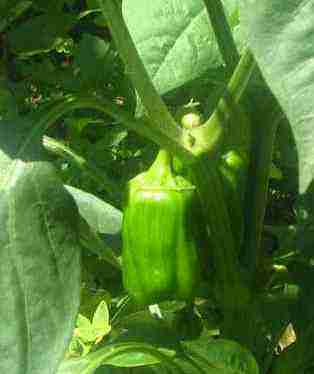
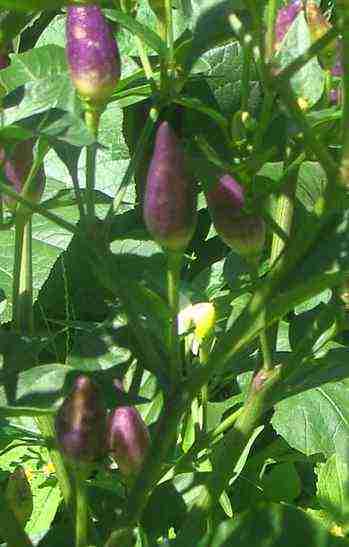
AUSTRALIAN PEPPERS are HOT!
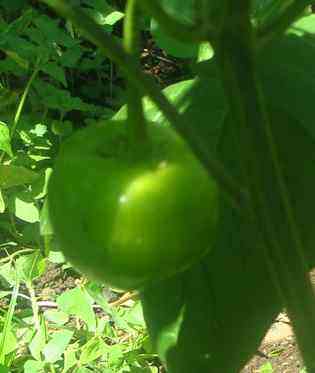
Peppadews
A little tip about peppadews is in order. We have grown them for years and they never seem to turn red. They produce a very heavy crop, too heavy for the branches which droop under their weight; and never ripen properly.
This season I built a crude frame for them to grow on out of an old Pride of India that had overstayed it is welcome. The long and very strong branches made the perfect frame; growing peppadews is a breeze.
These are well supported off the ground and, lo and behold, they have all turned red. All gardening, and how to grow chilli is no exception, is a learning curve. We are just waiting now for a few more and we'll be pickling them so we can enjoy peppadews year round. With ten bushes we will have bushels of them.
There is money to be made out of a peppadew cottage industry, methinks. They have grown to be our favourite, with less heat but all the flavour of chillis.
This salsa de peppadew is a great favourite in our family when they are in season.
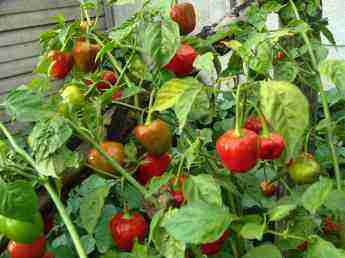
This is the first year I've grown jalapenos. Actually, they are not as fiery as I was expecting, but still too hot to eat raw. So I hollow out the pips and boil them briefly, and stuff them with hummus. Not with humus. Enjoy them with a large salad, or on bread they are simply divine.
This page at how to grow chillies is rambling now; apologies, but it goes with an aging mind, easily distracted. I have just made our panera bread menu recipe; it is so easy with a bread machine. I bake a loaf most days. Just the smell makes it worthwhile, and by adding olive oil and hummus to the dough you can turn it into low GI food.
Jalapenos
Jalapenos are perhaps my favourite pepper; not as hot as the chili, they have all the flavour, though perhaps rather less capsaicin. So, how to grow chilli would include these milder cousins in any case.
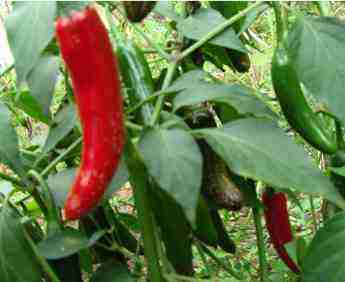
So many dishes to use your chillies. A divine healthy food; I have a sensitive stomach, but it handles these chillis and pepperdews and jalapenos without a problem.
See what a wonderful crop grew by following a legume? It's all the nitrogen fixation bacteria in the roots of beans and peas that make the next crop such a success.
So, as you can see, how to grow chilli is very high on our priority list.
Smoked chilli
Preserving your chillis could be interesting. I first slice them, perhaps remove the seeds, wearing glasses; and then freeze them. It's easy to open the bag and pull out a chunk to go in your curry or hummus; or Eggs Hilton.
This guy from down under has some great ideas on smoking chillies. I have not tried it yet, but it looks good, and he has obviously been at it for a long while. If you didn't give away those seven other plants, and have been learning how to grow them then give it a shot.
If you have a smoker then you can make your own chipotles. Apparently the world loves them but my education is lacking; when it comes to food there's always something new to try.
I reckon chipotles would be nice in our Baba Ghanoush recipe. After hummus that's my favourite way of keeping my cholesterol down so I can enjoy butter instead of margarine that I simply cannot and will not stomach. Foods that lower cholesterol is one of the most popular pages at this Bernard Preston site. Get off those nasty statins safely.
Look here for other best medicinal herbs and spices.
And now for a delicious chilli chicken recipe that will delight all in sundry. For those who keep their own birds, it is time to slaughter a young cockerel.
Daily ingestion of a phytochemical called capsaicin has been shown to be one solution to the anger in our muscles and joints that so many of us experience; plant and freeze your chilies.
Cross pollination
With ten beehives nearby, fiery red hot chilis are crossing with mild peppers and peppadews. Anything can happen if you get involved in how to grow chilli from your own seed; you will soon get to know that this plant is fiery, but that one is mild.
I simply remove some of the seeds if I find the peppadews are too hot in my roasted butternut soup recipe; then the grandchildren will not eat them.
Did you find this page useful? Then perhaps forward HOW TO GROW CHILLI to a fellow food and bookworm. And do not forget to download your copy of A Family Affair onto your Kindle or smartphone. Only one dollar each, though Amazon fudges the price regularly. You won't be sorry; it is a great book, if I say so myself.
A sequel is brewing. Santie discovers she has an Italian half brother; he's a cardinal with a difference. Georg is married, and he has ambitions of becoming pope; and reinstating the married priesthood of the first millennium of Catholicism. Always something spicy and different from Bernard Preston.
How to dry peppers
When you have a glut in the garden and you really want to have them year round, then you can freeze them. How to dry peppers is another option.
When browsing use right click and "Open Link in New Tab" or you may get a bad gateway signal.
Did you find this page interesting? How about forwarding it to a friendly book or food junkie? Better still, a social media tick would help.
Address:
56 Groenekloof Rd,
Hilton, KZN
South Africa
Website:
https://www.bernard-preston.com